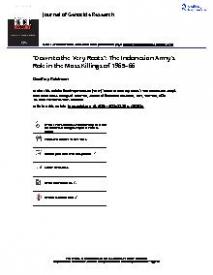“Down to the Very Roots” : The Indonesian Army’s Role in the Mass Killings of 1965–66
This article makes the case that the anticommunist violence of 1965–66 in Indonesia was neither inevitable nor spontaneous, but was encouraged, facilitated, directed and shaped by the Indonesian army leadership. It develops that argument in three parts. It shows first how the temporal and geographical variations in the pattern of mass killing corresponded closely to the varied political postures and capacities of army commanders in different locales, and how the mass violence everywhere depended on the army’s substantial logistical assets.
Next, it outlines how the army encouraged and directed mass killings by mobilizing militia groups and death squads, and encouraging them to detain and kill members of the PKI (Partai Komunis Indonesia—Indonesian Communist Party) and its allies. Third, it describes how the army provoked and legitimized mass violence by launching a sophisticated media and propaganda campaign that blamed the PKI for the kidnap and murder of six army generals on 1 October 1965, and called for the party and its affiliates to be physically annihilated.
The army had allies in this effort, none more enthusiastic than the anticommunist religious and political leaders who fanned the flames of hatred and violence by allusions to long-standing religious and cultural differences. Mass violence was also fuelled by the wider international context of the Cold War and by the acts and omissions of key foreign powers.
But without the army’s orchestrated campaign to cast the PKI as evil, without the conscious decision to effect its physical annihilation, and without the mobilization of the army’s considerable organizational and logistical capacity to carry out that decision, it is unlikely that any of those long-standing tensions or external forces would ever have given rise to violence of such staggering breadth and brutality.
In: Journal of Genocide Research, ISSN 1462-3528 ; eISSN 1469-9494 | 19 | 4 | 465–486
https://doi.org/10.1080/14623528.2017.1393935
This is an Open Access article distributed under the terms of the Creative Commons Attribution License (http://creativecommons.org/


